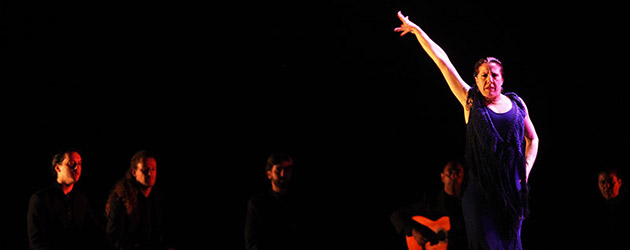Text: Estela Zatania
Photos: Antonio Acedo
18th Bienal de Flamenco de Sevilla
Wednesday, September 17th, 2014. 2030h. Teatro de la Maestranza
DÉJÀ VU WITH MARÍA PAGÉS
Dance: María Pagés, Isabel Rodríguez, María Vega, Eva Varela, Lucía Campillo, Sonia Franco, Macarena Ramírez, José Barrios, José Antonio Jurado, Paco Berbel, Rubén Puertas. Cante: Ana Ramón, Juan de Mairena. Guitar: Rubén Levaniegos, José Carrillo “Fyty”. Percussion: Chema Uriarte. Cello: Sergio Menem. Violin: David Moñiz. Choreography, director, wardrobe design: María Pagés. Music: Rubén Levaniegos, Isaac Muñoz, Georges Bizet, María Pagés, popular.
Wednesday there was torrential rain in Seville, and the weatherman warns not to expect much different today. But the grand event known as the Bienal de Flamenco de Sevilla follows the path of its intense program.
In the early afternoon, at the beautiful Espacio Santa Clara, singer Melchora Ortega defended her Jerez perspective, and at eleven o'clock, with the threatening weather requiring a change of venue to the Teatro Alameda, guitarists José María Gallardo and Miguel Ángel Cortés offered their work titled “Lo Cortés no Quita lo Gallardo”.
Between one event and the other, dancer María Pagés, one of the most admired dancers in Seville, and a fixture at this festival, presented the world premiere of her work “Siete Golpes y un Camino” conceived specifically for the Bienal, and as such, particularly apt for the dancer's numerous local following.
It's possible no one could express via dance such complex ideas as “the transformation of the incarnation of the serene dialect of time and the appropriation of the future”, that we read in the synopsis. From the same text, we learn that Pagés aims in this show to summarize her work of the last seven years, but the result feels needlessly repetitious, when we are used to being continually surprised by this dancer's choreographic genius and her excellent staging instincts. The diaphanous costumes, the tanguillo “rap”, the dances that end in silence and slow motion and the dancer's relentless serpentine forms are elements that have lost their edge through repetition. María has us spoiled with the extraordinary originality of previous works such as Utopía and Dunes which set a very high standard.
The off-stage voices in various languages could not be understood from where I was sitting in the spacious Maestranza. No sound-check can guarantee the correct amplification of this element which so rarely accomplishes its mission. The poetry of María Zambrano and others could not be appreciated, and ditto with the sung verses of Baudelaire, Machado, Lorca, Neruda and Cervantes among others. For the serious flamenco fan, the work would have been enhanced with less attention to the literary, and more to the dancing, although we must consider the diversity of the audience that attends the Bienal.
An interesting farruca is danced by the group, and an assortment of cantiñas by María who also gives a brief castanet demonstration. The dark wardrobe and scant lighting here employed are seldom seen in the works of Pagés. She dances tonás in the middle of a circle formed by the members of the company, and tientos that did have something new to say in this under-appreciated form, with tangos ending and La Tarara in slow motion. Trilla and soleá are danced by the disciplined company…so disciplined in fact that you have the feeling of watching a dance class; nowadays flamenco dance is more about the soloists than group numbers.
The show comes to an end with María, barefoot, dressed in a flowing electric red dress, the only touch of color in the entire work, moving to the sound of a granaína.
